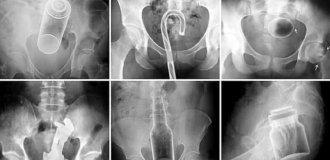UNIVERSAL AUSTRIAN automatic rifle AUG-77 (History of creation, design and much more...)
Elegant and beautiful, young, uniquely original, loved by men, terrifying in her professional skills. The star of the silver screen, the companion of villains and goodies, a formidable military weapon of today's reality, finally. And this is all about it - about the Austrian automatic rifle AUG-77

AUG ("Army General Purpose Rifle"), left view. The window for removing cartridges is covered with a shield, since in this case the cartridges are reflected to the right. If necessary, the direction of their reflection can be changed to the left. When the front handle is folded under the barrel, it is convenient to hold the rifle when shooting prone and from the knee.
TACTICAL AND TECHNICAL CHARACTERISTICS OF THE AUG FAMILY:

BORN TO MAKE A FAIRY TALE COME TRUE
60s XX century set task number one for the Austrian armed forces: to urgently find a worthy replacement for the FN model 58 assault rifle that was in service - a licensed version of the 7.62-mm Belgian FN FAL rifle, mass-produced by the factories of Steyr-Daimler-Puch AG. What caused this? A real revolution took place in the world of NATO ammunition then - a total transition from the traditional 7.62x51 caliber to the new automatic caliber - the promising 5.56x45 mm - was sharply outlined. The leading giant of the Austrian arms industry, Steyr-Daimler-Puch (now Steyr-Mannlicher), fearlessly took upon itself the burden of developing its own competitive weapons chambered for small-caliber cartridges. And not a simple weapon, but, if possible, an original and unprecedented one. And so it happened - the AUG system (“army universal rifle”), built according to the “bullpup” design that later became very popular, conquered the surprised world...

The beginning was made in 1969, when a young major from the Military Equipment Directorate of the Ministry of Defense, Walter Stoll, who had many unusual ideas, prepared the initial version of the layout of an assault rifle with a trigger mechanism and a moving system moved far back, into the butt, and a moving system operating by removal of part of the powder gases from the barrel. Stoll's idea was appreciated by the Austrian Minister of Defense, and already in 1970 a prototype was created at Steyr. No, it still bore little resemblance to the future AUG - the magazine was located in a solid pistol grip.

AUG, right view. With this position of the front handle, it is convenient to hold the rifle when shooting while standing
Over the next seven years, five different versions of this rifle were made, but only the sixth became the direct ancestor of the famous AUG. Stoll was no longer happy about this - for unclear reasons, he was removed from further developments, entrusting him with solving general issues. Around 1974, the leadership of the Directorate of Military Equipment appointed Captain Friedrich Dechant responsible for the development and acceptance of the new rifle. He zealously set to work, studying the design features of the most successful examples of individual small arms by prioritizing: the FN FAL (and the G-3 model) was famous for its shooting accuracy, the Soviet AK47 for its reliability, the American M16A1 for its accuracy of automatic fire. By bringing together the advantages of these systems, taking the best and fastening it all with a rather risky, then not really studied “bullpup” layout, Dehant created a miracle.

Early versions of the AUG rifle
PLASTIC TOY
The final version of the prototype AUG was ready for testing in 1976. The rifle successfully withstood 500 thousand rounds, but one of the Steyr engineers, Horst Wesp, expressed doubts about its reliability - it seemed too toy at first. It is unknown how the fate of the AUG would have turned out if the head of the design bureau of this company, Ulrich Ledrosser, had not supported Dehant, simultaneously indicating his participation in the project (in particular, proposing to increase the number of bolt lugs from three to eight, like the M16A1). As a result, all that remained of Stoll’s prototype was a removable barrel and two guide rods for the bolt frame. “Everything else was created from scratch,” Dehant later declared proudly. His brainchild looked very unusual, or better yet, fantastic to the extreme. The design consisted of six main blocks.
The barrel is easily replaceable, made of high-quality steel, its bore is chrome-plated to increase wear resistance (lifetime - 15 thousand shots), with six right-hand rifling and a pitch of 228 mm, on which an outer coupling is permanently attached. It contains a gas outlet unit (a gas hole; a gas regulator with two positions - normal and when the gas paths and moving parts of the rifle are excessively contaminated; a short gas chamber with a chrome-plated piston and an associated return spring). A special feature of the rifle was the displacement of the gas chamber from the barrel to the right and the hinged attachment from below to the outer coupling of the plastic front handle, which folds forward and has the remarkable property of serving as a convenient handguard during long-term shooting, despite the heated barrel. Another useful purpose of the handle is to facilitate the already simple process of changing the barrel to a new one (more on this a little later). The barrel is secured to a receiver made of die-cast aluminum using a special system of lug lugs, which significantly reduces the overall weight of the weapon. Corrosion resistance is achieved by anodizing treatment.
On top of the receiver there is a handle for carrying the rifle with a 1.5x optical sight built into it. On the upper surface of the latter’s tube there is a “spare” permanent open mechanical sight for shooting at a distance of up to 100 m.

Longitudinal section of AUG
Two guide rods of the bolt frame with return springs inside pass through the cylindrical channels of the receiver. The right rod serves as a pusher for the gas piston, transmitting impulse to the moving system when fired. The left one engages with a latch with a shaped plastic cocking handle that moves in a slot on the left side of the receiver. The bolt frame houses a lightweight bolt that locks the breech of the barrel by turning 22.3° to the left using seven lugs (an ejector is installed instead of the eighth). The rotation of the bolt is carried out by the interaction of its leading protrusion with the curvilinear groove of the bolt frame when the latter moves.

Incomplete disassembly of AUG. The numbers indicate:
1 - body;
2 - barrel with gas engine and front handle;
3 - receiver with optical sight and reloading handle;
4 - bolt frame with bolt, gas piston pusher and guide rod;
5 - trigger mechanism;
6 - back of the butt;
7 - swivel with pin;
8 - store.
The versatility indicated in the name of the rifle is determined by the modular design of the weapon. The main modules are: plastic housing; trigger mechanism; receiver with optical sight and charging handle
Perhaps what gives the weapon a special charm is the body-stock - made of fiberglass-reinforced polyamide, with a curved pistol grip, a huge (for shooting with mittens) trigger guard, a window for the magazine and a removable (fixed by a swivel pin) rubber back cover covering the butt from behind. Another block is hidden inside it - a trigger-type firing mechanism, assembled in an open plastic case. Almost all the parts of this unit, including the trigger itself, are made of plastic—admittedly a special, especially durable one. The placement of the trigger mechanism behind the fire control handle led to certain differences from the classic layout of automatic mechanisms: the pulling force of the trigger is transmitted by long sear levers, blocked by a safety pin in the form of a through pin running across the body-butt.
It is easy and simple to use: pressing from left to right turns on the safety, from right to left ensures the rifle is ready to fire. Changing firing modes is not entirely common - it is achieved by changing the degree of pressure on the trigger: a short press causes single shots, a long, strong press causes continuous fire (the self-timer lever does not allow you to fire a shot until the barrel is completely locked, holding the trigger in the cocked position) .

A slotted flash suppressor is screwed onto the muzzle of the barrel, and behind it there is a bracket for attaching a bayonet. Over most of its length, the surface of the trunk has small ribs. It is difficult to say how effectively they improve heat transfer, but as a dust and dirt collector their action can be considered impeccable

The gas chamber with a two-position regulator is located on the right side of the barrel. The gas engine assembly is structurally integrated with the base of the front handle

On the breech of the barrel there are two rows of lugs, with the help of which it is fixed in the receiver
Last but not least, the detail is a box-shaped, slightly curved magazine with a capacity of 30 rounds

The magazine is made of translucent plastic, which allows you to control the consumption of cartridges visually (American M193 or Belgian SS109) with their double-row arrangement. Visual control over ammunition consumption is simplified to the limit - the walls of the magazine are made of translucent plastic. The bold experiment of Austrian gunsmiths on the widespread (even ultra-wide) use of plastics in military small arms bore fruit: ten years later, this innovation ceased to be a curiosity - polyamide firmly took its place among modern materials in creating light and at the same time durable and reliable operation of weapons.

There are three holes in the rear widened part of the base of the front handle. The right one holds the gas piston, the left one secures the tip of the bolt frame guide rod, and the bottom one holds the barrel lock.
Undoubtedly, the reliability of a weapon is perhaps the main criterion for assessing its behavior in a combat situation. Resistance to shock loads, heat, humidity, cold, and resistance to a chemically aggressive environment ultimately determine the fate of the tested model - either eternal rest in the factory museum, or the path to the very top of the weapons hierarchy - into the army, into service with the army, police or other units.
Friedrich Dechant understood this better than others, paying the closest attention to reliability. The optical sight got the worst of it - tests for immunity to blows seemed not enough for Dehant; he took the rifle into the sauna, after which he immediately threw it into cold water. As a rule, the optics burst, and the manufacturer of the sights, Swarowski-Optic, again began to modify their product...

The core box is cast from aluminum alloy. A swivel is attached to its front part and a barrel lock with a button is visible. The reloading handle moves in the groove and remains stationary when firing

With a solid box, front and rear views
ADVANTAGES AND DISADVANTAGES
In 1977, while testing of the AUG was still ongoing, Steyr entered into a contract for the supply of 70 thousand rifles to Tunisia (it was specifically stipulated that this was to begin simultaneously with the transfer of the new system to the native Austrian army). A lucrative contract spurred work on the “finishing touches”, but haste, as we know, does not lead to good things. Ledrosser later admitted that the acceptance process was difficult - such little things as swivels, the back of the butt, and the sight clamp had to be modified already in mass production. In addition, at the Gokhfiltsen army training ground, problems were discovered in the locking unit, the connection between the bolt and the receiver, and in the magazine latch. The shortcomings were eliminated, the military came up with more and more new tests with mud, water, snow, heat and sand.
In the fall of 1978, mass deliveries of the 5.56-mm Steyr AUG-77 assault rifle to the Austrian army began. The new rifle was not immediately appreciated. It happened that at presentations and shows, army men tapped their fingers on the futuristic butt and asked: “Well, okay. This is a layout for an exhibition. Where is the real rifle? Some did not like the lack of a familiar fire translator, which supposedly leads to wastage of ammunition. Dehant responded to this like this: “From 90 to 95% of soldiers are lost in battle. The squad leader will be lucky if he has a couple of cool-blooded guys who will try to conduct aimed fire. The rest pull their heads into their shoulders and, without aiming, shoot in long bursts.”

The back of the butt has a rubber cushion to mitigate recoil. It is secured to the rifle body by a swivel pin, which can be installed on the right or left side of the body

After separating the back of the butt, access to the inside of the rifle body opens. The trigger mechanism is placed in the upper cavity, and the oiler in the lower cavity. The ends of the return mechanism rods are visible above the upper cavity
Then the optical sight, which was annoying at first, suddenly turned out to be quite convenient - at a distance of 300 m, the height target fit into a black ring, located instead of the traditional crosshair in the center of the sight's field of view, while the chest targets were located in the middle of the ring, and the more distant ones were placed on its lower side, which guaranteed a reliable hit on the target at a distance of up to 600 m. In addition, in poor visibility conditions, the black ring was distinguished better than the crosshairs.
Over time, even the most notorious skeptics recognized the advantages of the AUG: small size and weight, straightforward layout, which means a small recoil shoulder, an optical sight, quick assembly and disassembly (no more than 20 s), ease of maintenance and ease of use (except, perhaps, magazine changes), high reliability, resistance to cold up to -42 and heat up to 100°C. The left-handed soldier was also lucky - to shoot from the left shoulder, all that was required was to carry out a simple operation, quite feasible in the field: rearrange the ejector, changing the direction of cartridge extraction from the right to the left side, and closing one of the two windows (the right one) in the butt with a plastic cap.

With the help of a shaped cutout of the bolt frame and the leading protrusion of the bolt, the latter is rotated when locking and unlocking the barrel bore. Locking reliability is ensured by seven bolt lugs

The right rod of the bolt frame with an elongated tip serves as a pusher for the gas piston. The left rod is a guide and its tip is fixed in the hole in the base of the barrel handle when the bolt frame is in the forward position

At the rear, the bolt frame has two channels into which the guide rods of the return mechanism enter

The trigger mechanism is made of a separate block; all its parts, except springs and axles, are made of plastic
Experts also note the high fighting qualities of the Austrian rifle. Firing in bursts makes a pleasant impression; The accuracy of the AUG is superior to classic automatic rifles of 7.62 mm caliber.

The rifle receiver can have a universal bracket for installing various options for optical and night sights
MACHINE GUN, MACHINE GUN, SUBMACHINE GUN
The AUG would not be a “universal” rifle if it were not for its characteristic, truly outstanding feature - the ability to transform. Thanks to the easily (and most importantly, quickly) replaceable barrel, the AUG ceases to be a specific type of weapon - rather becoming a whole family. For example, we take the standard version with a 20-inch (508 mm) barrel, move the moving parts to the rear position, fix them by inserting the charging handle up into the slot of the receiver, press the barrel stop head down and to the left, and turn the barrel using the front handle and remove it moving forward. And if we now install a 407 mm long barrel in its place, we get a carbine with a 350 mm barrel - a small-sized machine gun for commando paratroopers, and by installing a heavy 621 mm barrel with a compensator and a height-adjustable bipod - a whole light machine gun, or, in the words developers, “light fire support weapon” HBAR.

White dots on the slot for easy aiming at dusk
The aiming mark of the optical sight is a ring, the diameter of which corresponds to the height of the target at a distance of 300 m

The front sight has a constant open sight. White dots along the edges of the slot and on the front sight make it easier to aim at dusk

The fire controls are located very conveniently and allow you to perform all actions with them without changing the position of the “shooting” hand. This hand can be either right or left. In fact, there are only two organs: the trigger, the degree of pressure on which determines the fire mode, and the push-button safety. The left safety position, shown in the photo, allows firing. To turn on the fuse, you need to move it to the right. With an unusually shaped trigger guard, it does not interfere with firing while wearing gloves or mittens

By replacing the barrel and moving automatic parts, the rifle can easily be transformed into an automatic carbine, light machine gun or submachine gun. Among the barrels used (from top to bottom): machine gun (621 mm long) with a bipod, standard 508 mm long, 407 mm long carbine, and also shortened to 350 mm in the “Raga” version for paratroopers

After replacing the standard barrel with a longer and heavier one, the rifle turns into a light machine gun
As for the machine gun, there are two modifications: LMG with a regular carrying handle with a built-in sight and LMG-T - with a specially shaped receiver with a bracket base for installing a telescopic sight or night vision device. The machine guns are equipped with extended magazines for 42 rounds. There are options with modified trigger mechanisms - firing can be carried out from the rear sear.
In addition, the AUG in a “rifle version” can be performed, at the customer’s request, both semi-automatically (firing only single shots) and with a burst cut-off for 3 shots.
The choice of accessories for the rifle is quite rich - in addition to all kinds of optics (telescopic, night, red dot sights), the weapon is equipped with a device for dry firing, a bayonet, and a Pi-M203 under-barrel grenade launcher (essentially an American M203 40 mm caliber with an effective grenade firing range up to 400 m).
But that's not all. In 1988, the Steyr AUG submachine gun chambered for the 9-mm Parabellum cartridge appeared. The standard assault rifle received a new 420 mm long barrel, a new inertial bolt and an adapter for installing box magazines from the MP69 submachine gun. The principle of operation is the recoil of the free shutter. Reviews about the “hybrid” are quite positive: excellent accuracy and high firepower at close ranges with a minimum of “externally imported” parts and components. The principle of universality works. Austrian rationalism triumphs.

Various mounting options:
For hand-to-hand combat, a rifle with a standard barrel can be attached to a bayonet.
In the AUG submachine gun version, there is no gas exhaust system and a silencer can be installed
Installation of a 40-mm under-barrel grenade launcher is also provided
WHAT'S NEXT?
The AUG rifle today occupies a strong place in the global arms trade system. Its various modifications are purchased by Tunisia, Saudi Arabia, Oman, Cameroon, Ecuador, Ireland, Luxembourg, Morocco, and it is widely used by police and special forces in many countries, including the US Customs Service. Since 1988, it has been produced in Australia at the state-owned arms factory in Lithgow for the needs of its own army (where the AUG is known under the brand name F88) and for export sales. The license to produce this weapon was acquired from Steyr-Mannlicher GmbH and Malaysia. In early 1998, negotiations were underway to conclude a similar deal with Portugal and Spain. In total, at least 500 thousand of these rifles have already been manufactured and their mass production continues.
According to a number of weapons experts, the AUG is the best among the bullpup assault rifles, leaving the English L85A1 and the French FAMAS far behind. However, like any weapon, it also has its drawbacks. Very often, cocking handles break, magazines crack, there are delays in the supply of ammunition, and soldiers are dissatisfied with the safety catch, which spontaneously changes its position during dashes. It is no coincidence that New Zealand, which ordered 18 thousand F88s from Australia, suspended the acceptance of 8 thousand rifles in November-December 1997 until the defects were eliminated. The natural question is: did all this arise as a consequence of licensed production or was it built into the design itself? The first assumption is supported by the fact that problems most often arise with “licenses”. Thus, the command of the Australian peacekeeping contingent operating under the auspices of the UN in Somalia recorded 26 involuntary shots from the F88, and in the Thai army this model did not pass the dirt test. On the other hand, maybe Steyr is specifically emphasizing the shortcomings of foreign AUG variants? One way or another, in 1998, the development company made some changes to the system. The cocking handle has been improved. The optical sight now has protrusions-fences near the adjustment knobs. But the most important thing is that the standard carrying handle (aka the sight) is removable. The rifle is supplied with a Weaver bracket with mounting space for mounting a whole range of different optical devices, including the electronic Holo Sight from Bushnell. In this form, the rifle received the AUG/A2 brand and began its new march through the world, already conquered 20 years ago by this truly universal infantry weapon.
PROCEDURE FOR INCOMPLETE DISASSEMBLY OF THE AUG RIFLE

Partial disassembly of the rifle begins with separating the magazine.
To do this, press the magazine release button with your thumb and separate it by moving it downwards (1). Unlike “Kalashnikov” magazines, this one is separated and attached with a straight movement, without turning (2). Before continuing disassembly, we make sure that there is no cartridge in the chamber. With the bolt frame retracted to the rear position, an empty chamber is visible through the window in the body. To separate the barrel, we fix the bolt frame pulled back by inserting the reloading handle into the cranked groove of the receiver (3). After this, holding the barrel with your left hand by the front handle, press the lock button down with your thumb (4). Then we turn the barrel towards ourselves by 45° and separate it from the receiver moving forward (5). We return the bolt frame to the forward position. In the rear part of the rifle body there is a window for the magazine, behind it there is a button for its latch. In front of the window there is a receiver lock - a rectangular pin. To separate the receiver with the optical sight and reloading handle, move the lock to the right as far as it will go (6) and remove the receiver by pushing it forward (7). When separated, the bolt carrier with the bolt is simply removed forward from the rifle body (8). The bolt cannot be separated from the bolt frame during partial disassembly.
To separate the back of the butt, press your thumb on the indentation in its rubber cushion and remove the swivel pin (9,10). The trigger mechanism assembly is simply removed back after separating the buttstock (11).





















